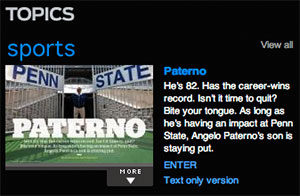 If you're a freelancer, and Time Warner owes you for assignments, for a fee you can get it paid in 25 days after it's approved. Want it in 10 days? The fee quadruples. Again, this is an acceleration of "approved payments", not the acceleration of payment. Reports of 60 to 90 day payment cycles abound,(despite claims that you are getting paid in 30 days) so at what point are they approved in the system? I highly doubt that you could actually get paid 10 days after sending your invoice, for example. The concept of "2/10 net 30", while common in the business world, assumes that you're actually getting paid in 30 days in the first place.
If you're a freelancer, and Time Warner owes you for assignments, for a fee you can get it paid in 25 days after it's approved. Want it in 10 days? The fee quadruples. Again, this is an acceleration of "approved payments", not the acceleration of payment. Reports of 60 to 90 day payment cycles abound,(despite claims that you are getting paid in 30 days) so at what point are they approved in the system? I highly doubt that you could actually get paid 10 days after sending your invoice, for example. The concept of "2/10 net 30", while common in the business world, assumes that you're actually getting paid in 30 days in the first place.
We all can understand the concept that if you have $100 owed to you, it is better for you to be paid that $100 immediately, than to have to wait a year for it. If you get that $100, compounded interest could mean that after a year in your bank account earning interest, you'd have $105 (or more). However, if you wait to be paid the year, your debtor has earned that same $105. This concept is called Time/Value of money, and you can read more about it here. While you may not be able to leverage a $5,000 early payment of a bill for an assignment (including expenses) into more than a few dollars, imagine JP Morgan (Time Warner's payment vendor) being able to leverage 100 of those $5,000 bills by delaying payments a month or two? That's called "the float." Banks used to delay making the funds available for upwards of 7 days even though they got the money within 24 hours. A long time ago, it might have taken 7 days to get a check drafted on a New York bank validated by a California bank. However, long after those days had passed, the delays were still in place, giving banks a 5-6 day "float" on your money, so that tens of millions of dollars could earn interest for just a few days, and you would be none-the-wiser. Laws were enacted to force banks to change.
Here's the "Happy Holidays" memo sent to Time Warner's freelancers:
(Continued after the Jump)
Happy Holidays!
If you are receiving this email, you are the JPMorgan Xign administrator and you, or someone from your organization, is submitting electronic invoices or receiving electronic payments via the JPMorgan Xign solution on behalf of Time Inc. I apologize for the blind distribution but I wanted to protect everyone's privacy while sharing this important information.
As year end approaches I wanted to ensure that you were aware of the PayMeNow functionality, which allows you to _accelerate payment for invoices that have already been approved_ by TIME. This is an excellent tool to help with your cash management at year end! This does not change your payment term on future invoices, it simply accelerates the payment on the ones you specifically request.
* If you are receiving this email, it means you have approved invoices that are pending payment and can be accelerated for payment this week or any day before year end. *
This is a purely optional service that is available to you by following these easy steps:
1) Log into your JPMorgan Xign account at xign.net.
2) Look for the green $$ and click the link.
3) This will display all available invoices
4) Either select the fastest date to be paid, or select "Lower rates" to schedule payment later in the month, but still before your year end.
Thanks very much and please let me know if you have additional questions related to cash acceleration. For all other inquires, please contact our Support Team at 800 485 XXXX.
Sincerely,
Linda Piazza
JPMorgan
Vice President, Relationship Management
It seems that a survey done by the JPMorgan Business Settlement Network, as reported by Financial Services Technology - Early payment discounts – a lucrative cash management tool - suggests that "faster payment" represents "one of the great earnings opportunities in corporate finance." The article encourages "You need to consider the amount of discount ‘leverage’ you have with a particular supplier." Then (and here's where the lowly freelancer comes in):"There is another large pool of suppliers...the non-strategic suppliers. These suppliers are typically small to mid-size suppliers...they are also the hungriest for cash and much more likely to accept discounts versus strategically sourced suppliers. Understanding your supplier’s need for cash is a key to success."
So, the next time you think that that Time Warner employee is your friend, or cares about you, remember, they are fronting for a payment system that wants you to be the "hungriest for cash and much more likely to accept discounts."
Gawker reports - Time Inc. Will Pay You Promptly, If You Pay Them for the Service - "Given how desperate freelancers are to be PAID NOW, largely because companies like Time Inc. never pay them on time, this is a pretty genius idea."
If you'd like to know more about the author of that missive, Linda Piazza's LinkedIn profile is here, and you can send her an email via LinkedIn, if you are so inclined.
Photography is business. Keeping your money longer and then giving you discounts, (as Gawker accurately describes it "charging its freelancers for the privilege of being paid for their work in a timely fashion") is Time Warner's business. So, you freelancers who fall into Time Warner's "non-strategic" category of vendors, remember how much they care when they won't pay you in full on time, despite your mortgage and credit card bills all being due in 30 day payment cycles, and you can't pay your bills.
Please post your comments by clicking the link below. If you've got questions, please pose them in our Photo Business Forum Flickr Group Discussion Threads.
[More: Full Post and Comments]



